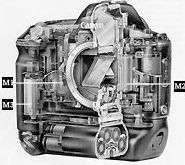.
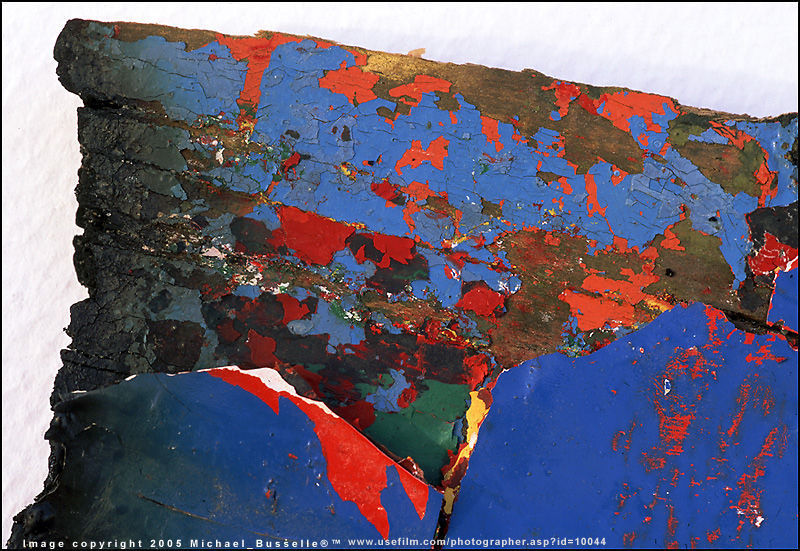 |
|
(2) Silent Film Rewinding The irritating rewinding noise of the EOS-1 has been greatly reduced in the EOS-1N through use of the measures outlined below, realizing quiet rewinding operation that allows use even in sensitive shooting situations.
| a) | The output shaft gear of the rewind motor (M2) has been changed from a pinion gear (as used in the EOS-1) to a worm gear, which reduces the initial stage gear-engaging noise and suppresses the high-frequency noise component that most greatly irritates the human ear. | |
| b) | The rigidity of the rewinding motor (M2) unit base plate has been increased, and six rubber bushings are used to provide a floating suspension between the M2 unit and the camera chassis and front plate, thus preventing transmission of vibration noise from the M2 unit to the camera chassis and front plate. | |
| (c) | In silent rewinding mode (selectable by setting CF-No. 1-2 or 1-3), the motor rpm is reduced through use of PWM (pulse width modulation) control, resulting in a further reduction of motor and gear-related noise. |
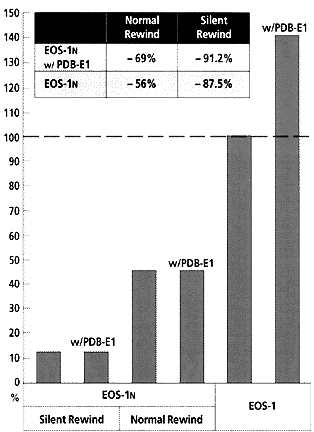 |
Table below shows a comparison of rewinding noise levels between various camera models and configurations, with the noise level of the EOS-1 set equal to 100. As can be seen, the above modifications to the rewinding system reduce the noise level to approximately 1/8 the level of the EOS-1, expanding the range of shooting situations in which the camera can be used without fear of disruption caused by loud rewinding noise. |
Film Rewinding Noise Comparison
| Model/Configuration |
Silent mode |
Normal mode |
| Canon EOS-1N |
48dB |
59dB |
| Canon EOS-1N+PDB-E1 |
48dB |
59dB |
| Canon EOS-1 |
- |
66dB |
| Canon EOS-1+PDB-E1 |
- |
69dB |
| Nikon F4 |
- |
66dB |
(3) Film Winding Speed and Shooting
Capacity The EOS-IN
with Power Drive Booster El has a maximum continuous shooting speed of approx. 6
fps (5 fps with fox:us prediction). The film transport system unit employs an extra
motor to achieve this high speed. The built-in twin-motor MD function and the three-motor
power-enhanced system achieved by attaching the PDB-E1 are the same as the earlier
Canon EOS-1. In fact, the Canon EOS-1N also employs the same basic mechanism construction
and operating sequence as the EOS-I, but incorporates modifications to the gear ratios
in the film transport, shutter and mirror mechanism charge systems to reduce the
drive time of each motor, thus achieving a faster continuous shooting speed. The
EOS-1N's film winding speed and shooting capacity under various conditions are provided
below for a quick glance:
Film Winding Speed
(fps)
| Mode | Al Servo AF | One-shot AF/Manual | Remarks |
| CH | approx. 6 | approx.5 | EOS-1N + PDB-E1 Power source: LR6 x 8 |
| CL | approx.3 | approx. 2.5 | EOS-1N + PDB-E1 Power source: FR6 x 8 |
| C | approx. 3 | approx. 2 | EOS-1N alone Power source: 2CR5 x I |
| EOS-1N + AA-size BP-E1; Power source: LR6 x 4 |
Film Shooting Capacity (rolls)
|
Configuration |
EOS-1N alone |
EOS-1N + AA-size BP-E1 |
EOS-1N + PDB-E1 |
|||||
|
Power source |
2CR5 x 1 |
2CR5 x 1 |
LR6 x 4 |
KR15/51x4 |
LR6 x 8 |
KR15/51x8 |
Ni-Cd Pack E1 |
|
|
Temperature |
Normal (20° C) |
75(50) |
75(50) |
45(30) |
18 (12) |
100(65) |
45(30) |
65(45) |
|
Low (-20° C) |
12(8) |
12(8) |
0(0) |
12(8) |
6(4) |
30(20) |
45(30) |
|
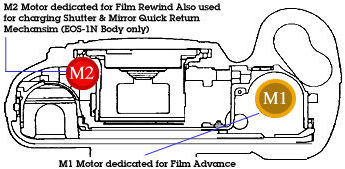 |
|
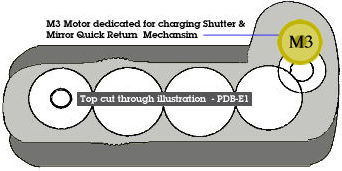 |
(4) Film Stop Position Control As mentioned earlier, the Canon EOS-1N
achieves a continuous shooting speed of 6 fps by increasing the gear ratio of the
film transport system. To prevent the reduction in film control performance that
such an increase in winding speed would introduce, the following modifications were
implemented to maintain film transport control performance on a par with the EOS-1
(a) Reduction of
the M-1 motor's rotor inertia By reducing the mass of the M-1 motor's rotor,
the rotor inertia was decreased by approx. 10%, resulting in improved motor response.
Rotor inertia (![]() ) EOS-1N: 0.46-0.50; EOS-1: 0.535-0.540
) EOS-1N: 0.46-0.50; EOS-1: 0.535-0.540
(b) Program duty control modification The EOS-1N uses the same program
duty control method as the EOS-1, but adds a lower duty factor (for increased brake
power) to offset the increased film winding speed. The EOS-1N also features increased
controllability by optimizing the duty factor switch-over points. Also, duty control
is not carried out when the system operates in low gear.
Program duty control: This control method achieves both high-speed film transport
and stable film stop position control by detecting in real-time the change in film
winding speed caused by changes in the power supply voltage, and employing duty control
optimized for that speed. This control method is called "program duty control"
because the duty factor is automatically selected from several preprogrammed types
(Canon EOS-1N, EOS-1 9 types; Canon EOS 10s QD: 11 types).
(5) Automatic Loading, DX-coded Film Speed Setting Same as the earlier Canon
EOS-1.
(6) Auto Rewind Also the same as the EOS-1.
In less than sub 10 seconds, from start to finish - 100m sprint event in any major sports meet can be another challenging task for photographers. It won't have another 50 laps like in F-1 or Motor GP - and it won't have another rematch other than another meet. The finish line is all that matter. Low available light, freeze action + many many factors to be considered by photographers.
![]() Credit:
Image courtesy of another good friend, Mr. Vincent Thian® Photo Editor of AP (Associated
Press, regional bureau/Malaysia)
on an assignment to cover the international sport event. Vincent also maintains an
AsianphotoGS.org. Selective of his older works can also be
found at a section of Windows in MIR site or at his Portfolio in MIR Image
copyright © 1996-2005. All rights reserved. Please respect the visual property
of the contributing photographer. Use of image does not suggest direct association
of actual equipment but rather for purpose of visual illustration only.
Credit:
Image courtesy of another good friend, Mr. Vincent Thian® Photo Editor of AP (Associated
Press, regional bureau/Malaysia)
on an assignment to cover the international sport event. Vincent also maintains an
AsianphotoGS.org. Selective of his older works can also be
found at a section of Windows in MIR site or at his Portfolio in MIR Image
copyright © 1996-2005. All rights reserved. Please respect the visual property
of the contributing photographer. Use of image does not suggest direct association
of actual equipment but rather for purpose of visual illustration only.
The film railing on top and bottom sections of the shutter curtain was made of stainless steel instead of aluminum alloy to ensure long lasting usage (one of the characteristic is, the more fiction, the more smooth it goes) and it has a better resistant to corrosion.
 |
As the film is advanced automatically, with each frame provided, it travels over/between precision-ground guide rails that serve to position the film emulsion surface exactly over the film gate. Aiding the two sets of guide rails in assuring film flatness are the film roller and the precision-finished film pressure plate, both attached to the interior of the camera back (take note:as total flatness of film is a key element to sharp focus - remember how the Kyocera's much publicized, award winning ceramic Film pressure plate on their Contax RTS III ?). |
Film feed to the take-up spool is precise via the sprocket roller provided between the spool and the film gate; this roller has sprockets at either end to engage the upper and lower perforations on the film, and thus provides smooth feed. One way or the other, as the motor-powered film advance and rewind has minimize many mechanical parts in the film transport and indirectly, fiction is lesser (so do static charge on high speed motorized film advance), it actually improves efficiency and reliability of the camera. Anyway, I don't think anyone would question the smoothness, precision and assuring with the EOS-1N's high speed film feed and silent operation, the entire visible construction when the back is opened, all it gives you the impression is rigid, solid and gives you plenty of confidence that this will be your last problem areas to worry about during shooting or even at the setup stage. Fantastic demonstration in combination of electrical and mechanical engineering at work here.
| Previous
| NEXT | Reliability Issue with Canon EOS-1N models
Film
Transport :- Part
I |
Part
Two
Relative:- Film Loading /Rewinding Process of Canon EOS-1N; Canon Command Back E1 (with Instruction Manual)
| Questions, Issues
& Answers
| Canon
EOS-1 Series Message
Board
|
Canon
EF lens Board
| in
a shared environment
|
Free Trade Zone |
shared
environment
| Back | Index Page The Canon EOS-1N
Series Professional SLR camera
|
Back | Main Index Page The Canon EOS-1
Series Professional SLR camera
Background and Various Issues
| The Basic
Features &
various Setup
Manual &
Auto Focusing |
Metering Systems | Exposure Control | Viewfinder
Optical
System Flash Photography (with Speedlite 540EZ extension & Selective info on Canon TTL Flash Models:-160E | 200E
| 300EZ | 300TL
| 420EZ | 430 EZ | 480EG | Macrolite
| Other non-TTL Canon flash model
Reliability Issues:- Body Chassis | Shutter Unit | Electronic Circuitry | Film Transport & film handling Secondary Functions:- Custom Function Part One | Part Two | System Accessories:- Film Back Options - instruction for Command Back E1 | Macro/Close Up Part one | Part two and Part III Flash for Macro-Photography | Power Sources -BP-E1 | PDB-E1 | Focusing Screens | Remote Control with Wireless Remote Set LC-3 | System compatibility
Variants of Canon EOS-1N:- Canon EOS-1N RS | Canon/Kodak Digital DCS-1, 3 -5 & 520/560 Series | Full Technical Specification | Main
Reference Map / Nomenclature
| Resource Centre:- Comparative Charts between EOS-1 &
EOS-1N / or with
its active Competition(s) (Nikon); Quick Operational Reference Card (278k Gif File);
Listings of 7-segment
digital numbers/letters
appeared on LCD display panel/viewfinders (HTML page); External Link:-Instruction Manual (3.3MB
PDF file applicable for both Canon
EOS-1N (RS). | Using EOS system for your photography | Bots & Nuts of EOS System - by Philip Chong |
The Eyes of EOS -
EF Lenses
A little OFF-TOPIC SOME Personal Thought
HOME - Photography in Malaysia |
Volunteered Maintainer(s) for the Canon EOS-1N Series Message Board: Philip Chong, Editor, Digital Camera Magazine; Vincent Thian, Photo Editor, Malaysian Bureau, Associated Press "AP", CYleow, Ex-photo Editor of local daily, The Star; Gary Rowan Higgins, Australia and other nice folks on the web.
Special Credit:- :Mr. Richard Yeow & Mr. Simon Wong from camera division of ![]() Marketing Malaysia, for their continual effort in
supporting development of this EOS/EF website. Others: All the nice people on earth who have contributed
their photos and pictures of personal works or product shots for the creation of
this site. Certain content and images appeared in this site were either scanned
from official marketing leaflets, brochures published by Nikon and/or contribution
from surfers who claimed originality of their own work for public publishing in this
website, where majority of the extracted information are used basing on educational
merits. The creator of this site will not be responsible for any discrepancies that
may arise from any possible dispute except rectifying them after verification from
respective source. Neither Nikon or its associates has granted any permission(s)
in using their public information nor has any interest in the creation of this site.
"Canon", "EOS",
"EF" "RT", "EOS-1n RS", "Booster
", "Macrolite", "fluorite", "Image Stabilizer"
& other applicable technical/business terms are registered trade name(s) of Canon
Inc., Japan. Site made with an Apple G5 IMac.
Marketing Malaysia, for their continual effort in
supporting development of this EOS/EF website. Others: All the nice people on earth who have contributed
their photos and pictures of personal works or product shots for the creation of
this site. Certain content and images appeared in this site were either scanned
from official marketing leaflets, brochures published by Nikon and/or contribution
from surfers who claimed originality of their own work for public publishing in this
website, where majority of the extracted information are used basing on educational
merits. The creator of this site will not be responsible for any discrepancies that
may arise from any possible dispute except rectifying them after verification from
respective source. Neither Nikon or its associates has granted any permission(s)
in using their public information nor has any interest in the creation of this site.
"Canon", "EOS",
"EF" "RT", "EOS-1n RS", "Booster
", "Macrolite", "fluorite", "Image Stabilizer"
& other applicable technical/business terms are registered trade name(s) of Canon
Inc., Japan. Site made with an Apple G5 IMac.

